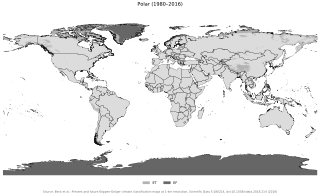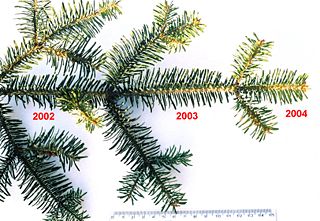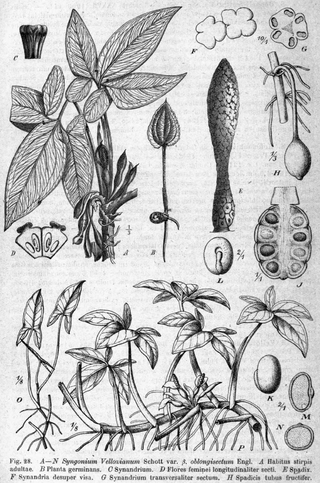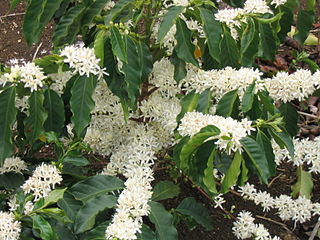
Taiga, generally referred to in North America as a boreal forest or snow forest, is a biome characterized by coniferous forests consisting mostly of pines, spruces, and larches.

The polar climate regions are characterized by a lack of warm summers but with varying winters. Every month a polar climate has an average temperature of less than 0 °C (32 °F). Regions with a polar climate cover more than 20% of the Earth's area. Most of these regions are far from the equator and near the poles, and in this case, winter days are extremely short and summer days are extremely long. A polar climate consists of cool summers and very cold winters, which results in treeless tundra, glaciers, or a permanent or semi-permanent layer of ice. It is identified with the letter E in the Köppen climate classification.

Norway is a country located in Northern Europe in the northern and western parts of the Scandinavian Peninsula. The majority of the country borders water, including the Skagerrak inlet to the south, the North Sea to the southwest, the North Atlantic Ocean to the west, and the Barents Sea to the north. It has a land border with Sweden to the east and a shorter border with Finland and an even shorter border with Russia to the northeast.

In botany, an evergreen is a plant which has foliage that remains green and functional through more than one growing season. This contrasts with deciduous plants, which completely lose their foliage during the winter or dry season.

Syngonium is a genus of flowering plants in the family Araceae, native to tropical rainforests in southern Mexico, the West Indies, Central and South America. They are woody vines growing to heights of 10–20 m or more in trees. They have leaves that change shape according to the plant's stage of growth, and adult leaf forms are often much more lobed than the juvenile forms usually seen on small house plants. The scientific name of the genus comes from the Greek words σύν and γονή and refers to the fused ovaries of female flowers.

Coffea arabica, also known as the Arabica coffee, is a species of flowering plant in the coffee and madder family Rubiaceae. It is believed to be the first species of coffee to have been cultivated and is currently the dominant cultivar, representing about 60% of global production. Coffee produced from the less acidic, more bitter, and more highly caffeinated robusta bean makes up most of the remaining coffee production. The natural populations of Coffea arabica are restricted to the forests of South Ethiopia and Yemen.
Hardiness of plants describes their ability to survive adverse growing conditions. It is usually limited to discussions of climatic adversity. Thus a plant's ability to tolerate cold, heat, drought, flooding, or wind are typically considered measurements of hardiness. Hardiness of plants is defined by their native extent's geographic location: longitude, latitude and elevation. These attributes are often simplified to a hardiness zone. In temperate latitudes, the term most often describes resistance to cold, or "cold-hardiness", and is generally measured by the lowest temperature a plant can withstand.

The common snook is a species of marine fish in the family Centropomidae of the order Perciformes. The common snook is also known as the sergeant fish or robalo. It was originally assigned to the sciaenid genus Sciaena;Sciaena undecimradiatus and Centropomus undecimradiatus are obsolete synonyms for the species.

Parachromis managuensis is a large species of cichlid native to freshwater habitats in Central America, where it is found from Honduras to Costa Rica. The binomial name refers to Lake Managua in Nicaragua, from which the holotype was obtained. It is a food fish and is also found in the aquarium trade where it is variously known as the jaguar cichlid, managuense cichlid, managua cichlid, guapote tigre, Aztec cichlid, spotted guapote and jaguar guapote. In Costa Rica it is known as the guapote tigre.

The wildlife of Costa Rica comprises all naturally occurring animals, fungi and plants that reside in this Central American country. Costa Rica supports an enormous variety of wildlife, due in large part to its geographic position between North and South America, its neotropical climate, and its wide variety of habitats. Costa Rica is home to more than 500,000 species, which represent nearly 5% of the species estimated worldwide, making Costa Rica one of the 20 countries with the highest biodiversity in the world. Of these 500,000 species, a little more than 300,000 are insects.

Páramo may refer to a variety of alpine tundra ecosystems located in the Andes Mountain Range, South America. Some ecologists describe the páramo broadly as "all high, tropical, montane vegetation above the continuous timberline". A narrower term classifies the páramo according to its regional placement in the northern Andes of South America and adjacent southern Central America. The páramo is the ecosystem of the regions above the continuous forest line, yet below the permanent snowline. It is a "Neotropical high mountain biome with a vegetation composed mainly of giant rosette plants, shrubs and grasses". According to scientists, páramos may be "evolutionary hot spots", that meaning that it's among the fastest evolving regions on Earth.

Garcinia intermedia is a species of tropical American tree which produces tasty fruit. In English it is known as the lemon drop mangosteen or sometimes monkey fruit. In Spanish it is called mameyito, though it is known as jorco in Costa Rica. In the Philippines, it is known as berba. In Portuguese it is called achachairu. The name achachairu is also applied to Garcinia humilis, another species native to Bolivia with larger, round or egg-shaped fruit. G. humilis has been commercialized in Australia under the name Achacha.

Syzygium malaccense is a species of flowering tree native to tropical Asia and Australia. It is one of the species cultivated since prehistoric times by the Austronesian peoples. They were carried and introduced deliberately to Remote Oceania as canoe plants. In modern times, it has been introduced throughout the tropics, including many Caribbean countries and territories.

Hedyscepe canterburyana, the big mountain palm or umbrella palm, is the sole species in the genus Hedyscepe of the family Arecaceae. It is endemic to Lord Howe Island, Australia and is threatened by habitat loss. It is a solitary palm with a distinct crownshaft, and bears unisexual flowers of both sexes. With the Rhopalostylis palms of Norfolk Island and New Zealand it forms the botanic subtribe Rhopalostylidinae. If differs from Rhopalostylis in minor floral details including having more than six stamens, and in being protandrous rather than protogynous. The two genera were formerly included in Archontophoenicinae until a recent revision. In some molecular phylogenetic analyses, Hedyscepe was found to be nested in the New Caledonia endemic Basselinia.

Justicia spicigera is an evergreen shrub with tubular orange flowers. The species is native to Belize, Costa Rica, El Salvador, Guatemala, Honduras, Mexico and Nicaragua.
Tropical ecology is the study of the relationships between the biotic and abiotic components of the tropics, or the area of the Earth that lies between the Tropic of Cancer and the Tropic of Capricorn. The tropical climate experiences hot, humid weather and rainfall year-round. While many might associate the region solely with the rainforests, the tropics are home to a wide variety of ecosystems that boast a great wealth of biodiversity, from exotic animal species to seldom-found flora. Tropical ecology began with the work of early English naturalists and eventually saw the establishment of research stations throughout the tropics devoted to exploring and documenting these exotic landscapes. The burgeoning ecological study of the tropics has led to increased conservation education and programs devoted to the climate.

The golden toad is an extinct species of true toad that was once abundant in a small, high-altitude region of about 4 square kilometres (1.5 sq mi) in an area north of the city of Monteverde, Costa Rica. It was endemic to elfin cloud forest. Also called the Monte Verde toad, Alajuela toad and orange toad, it is commonly considered the "poster child" for the amphibian decline crisis. This toad was first described in 1966 by herpetologist Jay Savage. The last sighting of a single male golden toad was on 15 May 1989, and it has since been classified as extinct by the International Union for Conservation of Nature (IUCN).

Deforestation is a major threat to biodiversity and ecosystems in Costa Rica. The country has a rich biodiversity with some 12,000 species of plants, 1,239 species of butterflies, 838 species of birds, 440 species of reptiles and amphibians, and 232 species of mammals, which have been under threat from the effects of deforestation. Agricultural development, cattle ranching, and logging have caused major deforestation as more land is cleared for these activities. Despite government efforts to mitigate deforestation, it continues to cause harm to the environment of Costa Rica by impacting flooding, soil erosion, desertification, and loss of biodiversity.

Montane ecosystems are found on the slopes of mountains. The alpine climate in these regions strongly affects the ecosystem because temperatures fall as elevation increases, causing the ecosystem to stratify. This stratification is a crucial factor in shaping plant community, biodiversity, metabolic processes and ecosystem dynamics for montane ecosystems. Dense montane forests are common at moderate elevations, due to moderate temperatures and high rainfall. At higher elevations, the climate is harsher, with lower temperatures and higher winds, preventing the growth of trees and causing the plant community to transition to montane grasslands and shrublands or alpine tundra. Due to the unique climate conditions of montane ecosystems, they contain increased numbers of endemic species. Montane ecosystems also exhibit variation in ecosystem services, which include carbon storage and water supply.

















